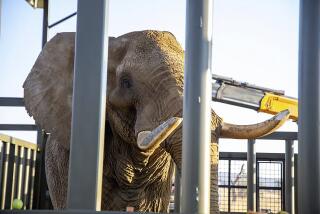‘Ivory Wars’ Looks at Africa’s Killing Fields
The rotting gray hulk lying on its side is an African elephant that has been killed by ivory poachers. “Oh, well,” sighs elephant specialist Iain Douglas-Hamilton. “Another one.”
The killing fields.
Viewed from certain angles, elephants almost seem to be smiling. The illusion is ironic, for overwhelming sadness, not amusement, prevails in “Ivory Wars,” a shocking program about the mass destruction of African elephants to gain possession of their creamy white tusks.
We’re not merely talking here about the immorality of using automatic weapons to randomly mow down magnificent, stately animals that have as much right to the Earth as humans do, but of a sort of wildlife genocide, the potential annihilation of an entire species.
“The prize is ivory, the price is extinction,” narrator James Earl Jones says in this superbly crafted, beautifully written, absolutely outraging hour airing at 6 p.m. today and again at 9 p.m. Wednesday on cable’s Discovery Channel, with other repeats coming on Saturday, Sunday and Oct. 7.
Produced by Tim Cowling, this is documentary as message art, and by the time it has ended, you’re so angry that you wouldn’t mind seeing the poachers and those who support them impaled like shish kebab on the very tusks they pull from their victims. Douglas-Hamilton and others are the program’s voices of reason.
At long last, the diverse animal-rights movement is beginning to gain the access to the media, and especially television, that it deserves. Made in association with the World Wildlife Fund, however, “Ivory Wars” marks the first time that a national television network itself has taken a public position on an animal-protection issue. That position, stated by the Discovery Channel in all its publicity, is that the ivory trade and survival of the African elephant in the wild are incompatible.
“Ivory Wars” also somewhat belatedly caps Discovery’s weekend block of Africa wildlife-oriented fare titled “Safari Live! Africa Watch,” which was highlighted by two live, half-hour telecasts on Saturday night from the spectacular Masai Mara National Reserve in Kenya.
Undertaken with the BBC, the ambitious live transmissions were marred by technical problems, an overreliance on talking heads, extreme brevity and the endemic narrowness of the small screen. Even so, some of the sights were breathtaking if only because they were live and unfiltered:
A lioness brought down a wildebeest. A massive buffalo chased off two young lions. And most spectacular of all, television witnessed another chapter being added to the million-year-old migration of the wildebeest.
Great numbers of these African antelopes swept into the Mara River, turning the muddy waters into a scene of utter chaos. “Once they start, nothing stops them,” said commentator Jonathan Scott. Nothing except drownings and feasting predators. The camera singled out one wildebeest being pulled beneath the water by a crocodile.
It was brutal, but it was also nature’s way, in contrast to the extreme plight of African elephants.
So many have fallen to poaching in the 1980s that if they continue to be killed at the same rate, they’ll be extinct in the wild in 25 years, Jones warns tonight. Extinct!
The enormous presence of these elephants can be felt even through the thick prism of television, and this program is an eloquent plea on behalf of them and the delicate balance of nature that would be critically upset should they vanish.
We see elephants standing beside the remains of another elephant almost like graveside mourners, “as if they see mirrored in the remains a shadow of their own destiny,” Jones says.
It’s a powerful image, and so is this one in Tanzania: huge numbers of tusks confiscated from poachers, neatly stacked in a warehouse like wood in a lumber yard. They sit there, an eerie testament to the efficiency of the killers, for whom elephants represent nothing more than cash to be paid them by middlemen, who themselves make a fortune by selling ivory on the international market.
In Kenya (which in July publicly burned the tusks of more than 1,200 elephants killed in the last four years), the camera accompanies government rangers on a mission to hunt poachers. They have some success. But all of the successes of the poorly paid and usually outgunned rangers are small beside the enormous international demand for ivory that keeps the poachers in business.
As we see tonight, the largest markets are Japan and Hong Kong, where much of the ivory that reaches the United States is carved into various kinds of artifacts. What a dramatic contrast in pictures: First, that meticulous craftsman the ivory carver at work, then that butcher the poacher at work, obtaining the ivory for the craftsman to carve.
An hour is not much time to tell a story as complicated as it is emotional. What “Ivory Wars” doesn’t do, therefore, is adequately explain the economic nuances of the ivory trade. While ending poaching is essential for Kenya, whose elephants bring in tourist dollars, for example, other countries are economically dependent on ivory.
Nor does the program explore the differences among those seeking to end elephant exploitation, or the possible options beyond total abolition of the ivory trade.
“Ivory Wars” is mildly critical of the position of ivory market controls--instead of abolition--adopted by the Convention on International Trade in Endangered Species of Wild Fauna and Flora. The U.S. Congress last year adopted legislation banning ivory imports from any nation not abiding by the convention’s controls, but some wildlife specialists feel those controls do not go far enough.
On the screen, flies swarm the remains of an elephant whose face has been hacked away by poachers, evoking a possible scenario that is becoming all too real. Are African elephants destined to become yet another species banished from the earth, memorialized only by trinkets, chopsticks and piano keys?
“They are gray shadows from Africa’s lost innocence,” Jones says, “their giant footprints growing fainter. If they vanish, we shall miss them when they’re gone.”
More to Read
The complete guide to home viewing
Get Screen Gab for everything about the TV shows and streaming movies everyone’s talking about.
You may occasionally receive promotional content from the Los Angeles Times.






